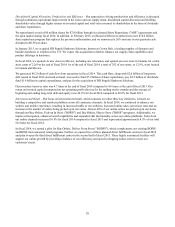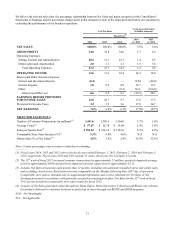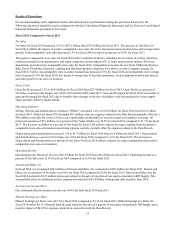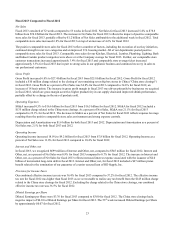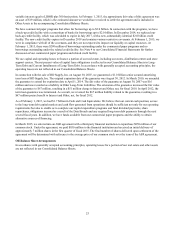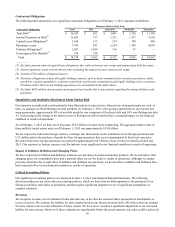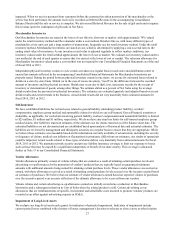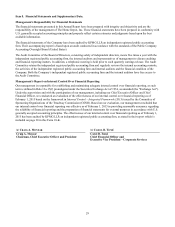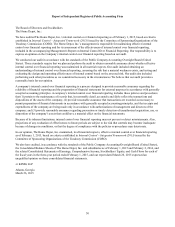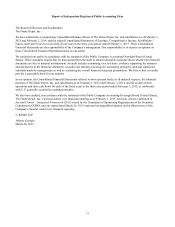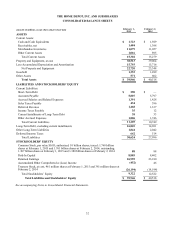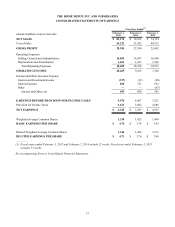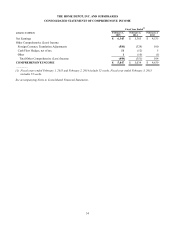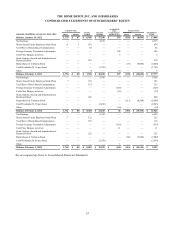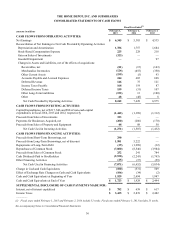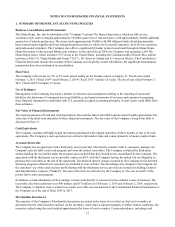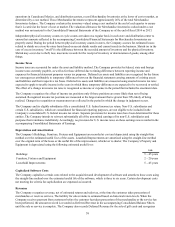Home Depot 2014 Annual Report Download - page 33
Download and view the complete annual report
Please find page 33 of the 2014 Home Depot annual report below. You can navigate through the pages in the report by either clicking on the pages listed below, or by using the keyword search tool below to find specific information within the annual report.
28
before the end of its previously estimated useful life or when changes in other circumstances indicate the carrying amount of
an asset may not be recoverable. The evaluation for long-lived assets is performed at the lowest level of identifiable cash
flows, which is generally the individual store level.
The assets of a store with indicators of impairment are evaluated by comparing its undiscounted cash flows with its carrying
value. The estimate of cash flows includes management’s assumptions of cash inflows and outflows directly resulting from
the use of those assets in operations, including gross margin on Net Sales, payroll and related items, occupancy costs,
insurance allocations and other costs to operate a store. If the carrying value is greater than the undiscounted cash flows, an
impairment loss is recognized for the difference between the carrying value and the estimated fair market value. Impairment
losses are recorded as a component of SG&A in the accompanying Consolidated Statements of Earnings. When a leased
location closes, we also recognize in SG&A the net present value of future lease obligations less estimated sublease income.
We make critical assumptions and estimates in completing impairment assessments of long-lived assets. Our cash flow
projections look several years into the future and include assumptions on variables such as future sales and operating margin
growth rates, economic conditions, market competition and inflation. A 10% decrease in the estimated undiscounted cash
flows for the stores with indicators of impairment would not have a material impact on our results of operations. Our
estimates of fair market value are generally based on market appraisals of owned locations and estimates on the amount of
potential sublease income and the time required to sublease for leased locations. A 10% decrease in estimated sublease
income and a 10% increase in the time required to sublease would not have a material impact on our results of operations. We
recorded impairments and lease obligation costs on closings and relocations in the ordinary course of business, as well as for
the China store closings in fiscal 2012, which were not material to the Consolidated Financial Statements in fiscal 2014, 2013
or 2012.
Goodwill and Other Intangible Assets
Goodwill represents the excess of purchase price over the fair value of net assets acquired. We do not amortize goodwill but
do assess the recoverability of goodwill in the third quarter of each fiscal year, or more often if indicators warrant, by
determining whether the fair value of each reporting unit supports its carrying value. Each year we may assess qualitative
factors to determine whether it is more likely than not that the fair value of each reporting unit is less than its carrying amount
as a basis for determining whether it is necessary to complete quantitative impairment assessments, with a quantitative
assessment completed at least once every three years. Our most recent quantitative assessment was completed in fiscal 2013.
In fiscal 2014, we completed our annual assessment of the recoverability of goodwill for our U.S., Canada and Mexico
reporting units. We performed qualitative assessments, concluding that the fair value of our reporting units was not more
likely than not less than the carrying value. In fiscal 2012, we recorded a charge of $97 million to impair all of the goodwill
associated with our former China reporting unit. There were no impairment charges related to our remaining goodwill for
fiscal 2014, 2013 or 2012.
We amortize the cost of other intangible assets over their estimated useful lives, which range up to ten years, unless such lives
are deemed indefinite. Intangible assets with indefinite lives are tested in the third quarter of each fiscal year for impairment,
or more often if indicators warrant. There were no impairment charges related to our other intangible assets for fiscal 2014,
2013 or 2012.
Recent Accounting Pronouncements
In May 2014, the Financial Accounting Standards Board issued Accounting Standards Update No. 2014-09, "Revenue from
Contracts with Customers (Topic 606)" ("ASU No. 2014-09"), which requires an entity to recognize revenue to depict the
transfer of promised goods or services to customers in an amount that reflects the consideration to which it expects to be
entitled in exchange for those goods or services. ASU No. 2014-09 supersedes most existing revenue recognition guidance in
U.S. GAAP. This guidance is effective for annual reporting periods beginning after December 15, 2016, including interim
periods within that reporting period, and early application is not permitted. The guidance permits the use of either the
retrospective or cumulative effect transition method. The Company is evaluating the effect that ASU No. 2014-09 will have
on its Consolidated Financial Statements and related disclosures.
Item 7A. Quantitative and Qualitative Disclosures About Market Risk.
The information required by this item is incorporated by reference to Item 7, "Management’s Discussion and Analysis of
Financial Condition and Results of Operations" of this report.




